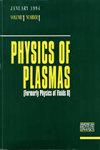EFIT-Prime: Probabilistic and physics-constrained reduced-order neural network model for equilibrium reconstruction in DIII-D
IF 2.2
3区 物理与天体物理
Q3 PHYSICS, FLUIDS & PLASMAS
引用次数: 0
Abstract
We introduce EFIT-Prime, a novel machine learning surrogate model for EFIT (Equilibrium FIT) that integrates probabilistic and physics-informed methodologies to overcome typical limitations associated with deterministic and ad hoc neural network architectures. EFIT-Prime utilizes a neural architecture search-based deep ensemble for robust uncertainty quantification, providing scalable and efficient neural architectures that comprehensively quantify both data and model uncertainties. Physically informed by the Grad–Shafranov equation, EFIT-Prime applies a constraint on the current density Jtor and a smoothness constraint on the first derivative of the poloidal flux, ensuring physically plausible solutions. Furthermore, the spatial location of the diagnostics is explicitly incorporated in the inputs to account for their spatial correlation. Extensive evaluations demonstrate EFIT-Prime's accuracy and robustness across diverse scenarios, most notably showing good generalization on negative-triangularity discharges that were excluded from training. Timing studies indicate an ensemble inference time of 15 ms for predicting a new equilibrium, offering the possibility of plasma control in real-time, if the model is optimized for speed.EFIT-Prime:用于 DIII-D 平衡重建的概率和物理约束降阶神经网络模型
我们介绍了 EFIT-Prime,它是 EFIT(Equilibrium FIT)的一种新型机器学习代用模型,集成了概率和物理信息方法,克服了与确定性和特设神经网络架构相关的典型局限性。EFIT-Prime 利用基于神经架构搜索的深度集合进行稳健的不确定性量化,提供可扩展的高效神经架构,全面量化数据和模型的不确定性。EFIT-Prime 以格拉德-沙弗诺夫方程(Grad-Shafranov equation)为物理依据,对电流密度 Jtor 施加约束,对极性通量的一阶导数施加平滑性约束,以确保物理上可信的解决方案。此外,诊断的空间位置被明确纳入输入,以考虑其空间相关性。广泛的评估证明了 EFIT-Prime 在各种情况下的准确性和鲁棒性,最显著的是,它对训练中排除的负三角形放电具有良好的泛化能力。时间研究表明,预测一个新平衡的集合推理时间为 15 毫秒,这为实时等离子体控制提供了可能性,前提是对模型的速度进行优化。
本文章由计算机程序翻译,如有差异,请以英文原文为准。
求助全文
约1分钟内获得全文
求助全文
来源期刊

Physics of Plasmas
物理-物理:流体与等离子体
CiteScore
4.10
自引率
22.70%
发文量
653
审稿时长
2.5 months
期刊介绍:
Physics of Plasmas (PoP), published by AIP Publishing in cooperation with the APS Division of Plasma Physics, is committed to the publication of original research in all areas of experimental and theoretical plasma physics. PoP publishes comprehensive and in-depth review manuscripts covering important areas of study and Special Topics highlighting new and cutting-edge developments in plasma physics. Every year a special issue publishes the invited and review papers from the most recent meeting of the APS Division of Plasma Physics. PoP covers a broad range of important research in this dynamic field, including:
-Basic plasma phenomena, waves, instabilities
-Nonlinear phenomena, turbulence, transport
-Magnetically confined plasmas, heating, confinement
-Inertially confined plasmas, high-energy density plasma science, warm dense matter
-Ionospheric, solar-system, and astrophysical plasmas
-Lasers, particle beams, accelerators, radiation generation
-Radiation emission, absorption, and transport
-Low-temperature plasmas, plasma applications, plasma sources, sheaths
-Dusty plasmas
 求助内容:
求助内容: 应助结果提醒方式:
应助结果提醒方式:


